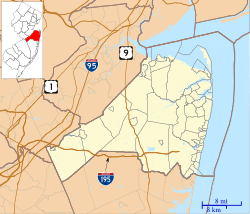Christ Church (Middletown, New Jersey) facts for kids
Quick facts for kids Christ Church |
|
|---|---|
| Christ Episcopal Church | |
 |
|
| 40°23′38″N 74°07′04″W / 40.39389°N 74.11778°W | |
| Location | Middletown Township, New Jersey |
| Country | United States |
| Denomination | Episcopal |
| Churchmanship | Anglican Communion |
| History | |
| Status | Church |
| Founded | 17 October 1702 |
| Dedicated | 1738 |
| Events | Sir Henry Clinton and Lord Cornwallis leaving the Battle of Monmouth meet at the Church corner. Some of the wounded were housed in the Church. |
| Architecture | |
| Functional status | Active |
| Style | Neo-gothic |
| Years built | 1744-1745 |
| Groundbreaking | 1744 |
| Completed | 1745 |
| Specifications | |
| Length | 53 feet (16 m) |
| Width | 40.25 feet (12.27 m) |
| Height | 16.5 feet (5.0 m) |
| Materials | Large, hand-shaped rough stone |
| Bells | 1 |
| Administration | |
| Episcopal area | Episcopal Church in the United States of America |
| Diocese | Episcopal Diocese of New Jersey |
| Province | Province II |
Christ Church is a very old church located in Middletown Township, New Jersey. It was built in 1744 and is an important part of the area's history.
Contents
History of Christ Church
Starting the Church
The first services for the Church of England in Middletown likely happened in the 1680s. They were held in the home of Alexander Innes, who used to be a chaplain in New York. At that time, Middletown was known for being a bit wild. Some people even helped hide pirates!
In 1701, Lewis Morris, who was the British Governor of New Jersey, wrote to the Bishop of London. He described Middletown as a "wicked" place. He said that Sunday meetings, which were probably church services, often turned into fights or races.
Things started to change in 1702. A missionary named George Keith arrived from the Society for the Propagation of the Gospel in Foreign Parts. Along with Alexander Innes, they officially started Christ Church on October 17, 1702. For a few years, services continued in private homes. Then, in 1705, Judge John Johnson, a friend of Innes, allowed them to use the old Monmouth Patent courts as a church.
In 1738, King George II gave the church an official document called a charter. This charter was signed by Governor William Burnet. By 1744, the church building was being constructed. It was finished the next year, in 1745, and services began there.
During the American Revolution
Even though many battles and small fights happened nearby, the church building was not damaged during the American Revolution. After the Battle of Monmouth, two important British generals, Sir Henry Clinton and Lord Cornwallis, met at the corner of King's Highway and Church Lane. Some soldiers who were hurt in the battle were even cared for inside the church.
After the American Revolution ended successfully, Christ Church sent representatives to the very first meeting of the Protestant Episcopal Church in the United States.
A Pirate's Gift to the Church
In 1736, a man named William Leeds left a large gift of land and money to Christ Church. Leeds was known to have worked with the famous pirate Captain Kidd. The story of how he got his wealth made his donation quite interesting.
After a time as a pirate, Leeds settled in the Ideal Beach area of Middletown. He and some of his shipmates married women from the township. To make up for his past actions, Leeds set up a special fund. This fund would give money and his property at Swimming River to both the Middletown Christ Church and the Shrewsbury Christ Church after he passed away.
People believe that Leeds's large fortune came from his time as a pirate. However, Leeds was a member of the Society of Friends, a group known for being peaceful. He was not involved in any violence during his time as a pirate. Leeds died in 1739.


